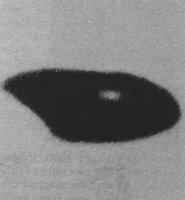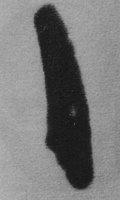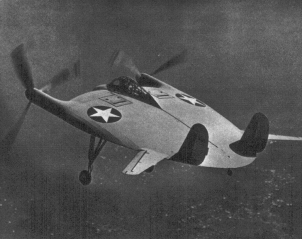Although the reliability isn’t quite as high as the pictures taken in McMinnville, two shots taken in Phoenix do rank right up there. William A. Rhodes, a self-employed scientist living in Phoenix, reported that he had taken what might be considered the first good photographs of one of the flying discs. Rhodes said he had been on his way to his workshop at the rear of his house at the rear of his house when he heard a distinctive "whoosh" that he believed to be from a P-80 "Shooting Star" fighter jet. He grabbed his camera from the workshop bench and hurried to a small mount in his backyard. The object was circling in the east about a thousand feet in the air.
house when he heard a distinctive "whoosh" that he believed to be from a P-80 "Shooting Star" fighter jet. He grabbed his camera from the workshop bench and hurried to a small mount in his backyard. The object was circling in the east about a thousand feet in the air.
 house when he heard a distinctive "whoosh" that he believed to be from a P-80 "Shooting Star" fighter jet. He grabbed his camera from the workshop bench and hurried to a small mount in his backyard. The object was circling in the east about a thousand feet in the air.
house when he heard a distinctive "whoosh" that he believed to be from a P-80 "Shooting Star" fighter jet. He grabbed his camera from the workshop bench and hurried to a small mount in his backyard. The object was circling in the east about a thousand feet in the air. Rhodes sighted along the side of his camera and took his first photograph. He advanced the film, and then hesitated, thinking that he would wait for the object to get closer. Then, worried that it would disappear without coming closer, snapped the second picture, finishing the role.
Rhodes’ story, along with the pictures, appeared in the Phoenix newspaper, The Arizona Republic. In the article, reporter Robert C. Hanika, wrote, "Men long experienced in aircraft recognition studied both the print and the negative from which they were made, and declined to make a guess on what the flying object might be."
He also wrote, "The marked interest Rhodes has for all aircraft has led most persons who have been in contact with other observers of the 'flying discs' to believe the photographs are the first authentic photographs of the missiles, since Rhodes easily can identify practically any aircraft."
Rhodes said that the object appeared to be elliptical in shape and have a diameter of twenty to thirty feet. It appeared to be at 5000 feet when first seen and was traveling, according to Rhodes, at 400 to 600 miles an hour. It was gray which tended to blend with the overcast background of the sky.
The object had, according to Rhodes and a confidential report from the Project Blue Book files, "what appeared to be a cockpit canopy in the center which extended toward the back and beneat
 h the object. The 'cockpit did not protrude from the surface but was clearly visible with the naked eye." There were no propellers or landing gear, but there did seem to be trails of turbulent air behind the trailing points of the object. Speculation was that there were jet engines of some kind located there. The craft moved silently, although Rhodes had said that a jet-like roar was what called his attention to it.
h the object. The 'cockpit did not protrude from the surface but was clearly visible with the naked eye." There were no propellers or landing gear, but there did seem to be trails of turbulent air behind the trailing points of the object. Speculation was that there were jet engines of some kind located there. The craft moved silently, although Rhodes had said that a jet-like roar was what called his attention to it.The news stories apparently alerted the military to Rhodes' sighting. Various investigations were launched. On July 14, 1947, Lynn C. Aldrich, a special agent for the Army's counterintelligence corps (CIC) in a memo for the record available in the Project Blue Book files wrote, "On 8 July 1947, this Agent obtained pictures of unidentifiable objects (Exhibits 1 and 2) from the managing editor of the Arizona Republic newspaper. The pictures were taken by Mr. William A. Rhodes... [of] Phoenix, Arizona, at sunset, on 7 July 1947."
Then, on August 29, according to a "Memorandum for the Officer in Charge," George Fugate, Jr., a special agent of the CIC and stationed at Fourth Air Force Headquarters, interviewed Rhodes in person. Fugate was accompanied by Special Agent Brower of the Phoenix FBI Office. This interview is important because of some of the confusion about location of the negatives and prints of the photographs that would develop later.
During the intervi
 ew, Rhodes again told the story, suggesting that he thought, at first, it might have been the Navy's "Flying Flapjack" (seen at the left) which had been featured on the May 1947 cover of Mechanix Illustrated. He rejected the idea because he saw no propellers or landing gear. Research shows that the Navy built a single "Flapjack" and that it never flew outside the Bridgeport, Connecticut area.
ew, Rhodes again told the story, suggesting that he thought, at first, it might have been the Navy's "Flying Flapjack" (seen at the left) which had been featured on the May 1947 cover of Mechanix Illustrated. He rejected the idea because he saw no propellers or landing gear. Research shows that the Navy built a single "Flapjack" and that it never flew outside the Bridgeport, Connecticut area.At the end of Fugate's report, he wrote, "Mr. Rhodes stated that he developed the negatives himself. He still had the negative of the first photograph (Exhibit III), but he could not find the negative for the second photograph."
On February 19, 1948, Lewis C. Gust, the chief, Technical Project Officer, Intelligence Department (though the Project Blue Book files fail to identify the man or his organization beyond that), wrote what might be considered a preliminary report on the analysis of the photographs. "It is concluded that the image is of true photographic nature, and is not due to imperfections in the emulsion, or lack of development in the section in question. The image exhibits a 'tail' indicating the proper type of distortion due to the type of shutter used, the speed of the object and the fixed speed of the shutter. This trailing off conforms to the general information given in the report."
On May 11, 1948, Rhodes was again interviewed but this time by high-ranking people. Lieutenant Colonel James C. Beam, who worked with the head of intelligence at Wright field Colonel Howard McCoy, and Alfred C. Loedding, who was a civilian employee at AMC and part of Project Sign, traveled to Phoenix. In their official report of their trip, they wrote, "Although Mr. Rhodes is currently employed as a piano player in a night club, his primary interest is in a small but quite complete laboratory behind his home. According to his business card, this laboratory is called "Panoramic Research Laboratory and Mr. Rhodes is referred to as the 'Chief of Staff.' Mr. Rhodes appeared to be completely sincere and apparently is quite interested in scientific experiments."
During the interview with Beam and Loedding, Rhodes mentioned that he did not believe that what he had seen was wind blown debris. This is an obvious reference to Dr. Irving Langmuir's conclusion published in the "Project Grudge Report," that the object in the photographs could be "merely paper swept up by the winds."
In fact, that same Grudge Report noted, "In subsequent correspondence to the reporter of this incident, the observer refers to himself as Chief of Staff of Panoramic Research Laboratory, the letterhead of which lists photography among its specialities. Yet, the negative was carelessly cut and faultily developed. It is covered with streaks and over a period of six months, has faded very noticeably."
The AMC opinion in the Project Grudge report, which followed Langmuir's statement about the possibility of wind blown debris, was, "In view of the apparent character of the witness, the conclusion of Dr. Langmuir [that the photographs be discounted as paper swept up by the wind] seems entirely probably (sic)."
On June 5, 1952, now nearly five years after the pictures were taken, and before the massive publicity about UFOs was about to burst on the public consciousness, Colonel Arno H. Luehman, Deputy Director of Public Information wrote about "Declassifying Photographs of Unidentified Flying Objects." In the first paragraph of his letter, he wrote, "This office understands that two photographs were taken by Mr. William A. Rhodes of Phoenix, Arizona, and that these photographs were turned over to Fourth Air Force Intelligence in July of 1947. This office has been contacted by Mr. Rhodes who is requesting return of his original negatives."
The letter continued, "The two photographs were copied by the Photographic Records and Services Division of the Air Adjutant General's Office at this headquarters and are in a confidential file of Unidentified Missiles as A-34921AC and 34921AC."
But the important part of the document comes at the end. Aldrich wrote, "...On the morning of August 30, 1947, when Mr. Rhodes called at the Phoenix office [of the FBI] to deliver the negatives, they were accepted only after he was advised that they were being given to Mr. FUGATE, a representative of the Army Air Force Intelligence, United States Army, and that there was little, if any chance of his getting the negatives back. Mr. Rhodes turned them over to this office with the full understanding that they were being given to the Army and that he would not get them back."
On July 14, 1952, in still another letter, we learn that the pictures and negatives were turned over to Air Force intelligence representatives at Hamilton Field on August 30, 1947. In that document, they are attempting to trace the course of the pictures from Rhodes to the FBI to Army intelligence. What this suggests is that the Air Force wasn't sure of where the pictures and negatives were. They were attempting to shift the blame to others for the apparent loss of those pictures, including Rhodes himself.
That same July 14 document, written by Gilbert R. Levy, noted, "A background investigation was run on Rhodes, by OSI, for the benefit of AMC, which reflected Rhodes had created the name PANORAMIC RESEARCH LABORATORY, to impress people with his importance. He was reported to be a musician by trade, but had no steady job. Neighbors considered him to be an excellent neighbor, who caused no trouble, but judged him to be emotionally high strung, egotistical, and a genius in fundamentals of radio. He conducts no business through his ‘Laboratory,’ but reportedly devotes all his time to research."
What all this means is that Rhodes had surrendered his photographs and negatives to the government. And, although there is a suggestion that he knew where they were, that simply isn't borne out in the documents. Even the Air Force officers didn't know where the photographs were. That was why there were letters written from one office to another.
But, more importantly, there has been no real discussion about why the Air Force investigators labeled the case as a probable hoax. The discussion seemed to center around Rhodes' lifestyle. He didn't have a "real" job and had letterhead that labeled him as the chief of staff of his laboratory. None of that is a good reason for labeling the case a hoax. If that was all their evidence, then it is fairly weak.
There is, however, one page of analysis of the photographs offered by John A. Clinton. There is no clue, in the files, about Clinton. The analysis is not on a letterhead and there is nothing in the signature block to tell us anything about Clinton, his expertise, or why he was consulted about this particular case.
In the undated analysis of the photographs, Clinton wrote, "Preliminary analysis of the negative and prints leads me to doubt the story told by Mr. William A. Rhodes. Judging from the dimensions, the negative was exposed in a simple camera of the box type, which usually has a fixed focus (about ten feet), fixed shutter speed (about 1/25 of a second) and a simple lens of the Meniscus type. Because of the above mentioned facts, it is unreasonable to assume that sharp outlines such as appears on the negative, could be secured from an object at 2,000 feet, traveling 400 to 600 mph. Furthermore, according to the story the object (flying craft) was painted gray to blend in with the clouds. But, even if the object would be painted jet black, under the circumstances described, to obtain a contrast such as appears on the negative is also very doubtful. On all the prints, excepting the print marked "exhibit A", judging from the outlines, the object has a rotating motion (revolves around its center) instead of a forward motion, contracting the version stated by Mr. Rhodes."
And that's all of the negative analysis of the photograph. Clinton, whoever he is, claimed the story told by Rhodes to be in conflict with that shown on the photographs. He assumed that the object is rotating based on something he saw on the prints. Besides, Rhodes talked of the craft circling east of his house, moving north to south when he first saw it. This seemed to be an explanation for the conclusion drawn by Clinton that might suggest the object is rotating.
More important are the suggestions about the limitations of the camera used and the sharpness of the photographs obtained. Of course, if Rhodes, for whatever reason, overestimated the distance and the speed, then those problems might be resolved.
By 1952, when Rhodes was trying to get the pictures back, Air Force investigators, including the then Captain Dewey Fournet suggested in a telephone conversation with the then Lieutenant Ed Ruppelt, that "There is no information available as to whether or not Rhodes ever sent his negatives to the Air Force or whether he just sent prints. We do have some rather poor quality prints of the object. As you know, we have concluded that these photos were probably not authentic. If seems as if Mr. Rhodes attempted to get on the 'picture selling bandwagon' and if he can prove he sent the negatives to ATIC or to the Air Force and they were never returned, it may lead to a touchy situation."
So now, after all this, Rhodes' photographs are going to be rejected because he wanted to sell them. Five years after the fact, without a single clue that such was the case, the Air Force rejected the photographs because Rhodes "may" want to sell them. There is no evidence anywhere that Rhodes ever sold the photographs nor is there any information in the Project Blue Book files to confirmed he made a dime from the pictures.
There is one disturbing thing about the case but is not evident in the Blue Book file. In the mid-1960s, Dr. James E. McDonald corresponded with Rhodes about his case. McDonald wrote to Richard Hall, of NICAP (and later of the Fund for UFO Research), on February 18, 1967 that "I did a lot of checking on Rhodes degrees, because there seemed something odd about an honorary Ph D based on the kind of work I could imagine him doing. Columbia said no record of any such degree. Geo. Washington said no record of a BA ever given to Rhodes in the period I specified. So I made a trip up there in December and spent an hour or so with him. Devoted most of my querying to the matter of the degree and his associations with inventory (sic), Lee DeForrest... He [Rhodes] showed me a photo-miniature in plastic of the alleged Columbia degree, and he said he had the original somewhere in his files but did not show it to me... As I kept going over the thing he finally volunteered the remark that he, himself, had checked with Columbia about a year after DeForrest presented him with the certificate, found no record of it, confronted DeForrest with the information, and was non-plussed by D F putting his arm over his shoulder and saying something to the effect, that, 'Well, my boy that's the way those things happen sometimes,' and saying no more about it... But the fact that he lists himself in the Phoenix phonebook as Dr. Wm Rhodes in the face of that history constitues (sic) a cloud that would be impossible to overlook. Everything else checks out solidly in his story."
There isn't much else to be said about the case. The Air Force eventually removed the possible from in front of hoax and listed it as "Other (Hoax)." They had no other explanation for it and too often, when they could find no plausible explanation, especially in cases of physical evidence such as this, they labeled it as a hoax. As we've seen, there simply is no justification for the label. Rhodes just fit no easy profiles so it was easy to label him an eccentric and his case as a hoax.
But the real facts that remain is that no one ever showed that Rhodes tale of seeing the craft was not as he described it. Analysis of the photographs left a great deal to be desired but there was nothing in the photos that suggested hoax.
Greetings Kevin from Ireland!
ReplyDeleteWhat you have been saying all along will in time be greatly appreciated. All in good time. Yes, all in good time.
Cordially,
Richard of eTidings
Kevin,
ReplyDeleteThe first photo here reminds me a bit of this photo from the Vancouver area:
http://ufoevidence.org/photographs/section/recent/Photo401.htm